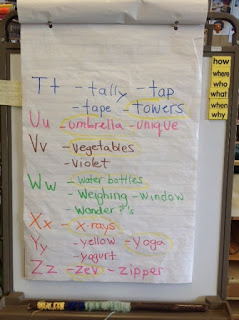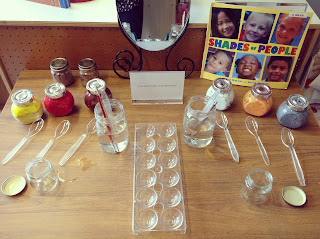Similar to last year, we started out this year with an paint trolley containing various sizes of paint brushes and a number of empty glass containers that would eventually be used to hold paint. It took a couple weeks before one child inquired about paint because she wanted to paint a picture. This was the perfect opportunity to introduce colours to the children.
This past summer I re-read the beautifully written book called "The Language of Art" by Ann Pelo. Among the many wonderful chapters, one in particular stuck out to me because it contained such a unique introduction on colours and colour mixing. This was my inspiration for the black and white paint colour provocation I set up for the children.
What do you notice when black and white play together?
White and black are fascinating colours because they have such a strong contrast when they are close together. With the hope of exploring and investigating their relationship, a provocation using black and white tempera paint was set up for the children. Using a hands-on active approach encompassing the use of many senses, the children were able to observe and notice how black and white "play" together on white and black paper.
“I made two different kinds of grey because I
put a little more white on the black and a little more black on the white. On
the black it looks more darker because it’s black. On the white paper it looks
lighter.” C. C.
“I wonder
why it’s making black?” (Placed white paint on black paper) “Maybe because white is
clear and it’s not a colour.” P. M.
“White and
black makes grey!”
“I can’t see
it on the black paper (black paint on black paper)." S. F.
“I put black
paint on the white paper and I gotted white paint and then I mixed it and it
turned into grey. It turned
way darker because it was made all out of dark colours.” M. O.
“I noticed that this one turned brown (when
placing black and white paint on white paper). When I put white paint on the
black paper it turned grey.” A. F.
"I did a pattern, black, white, black, white, then it turned grey!" C. D.
“It makes it
look darker because it’s the white paper and the black makes it look darker. I put the white on the
black paper and added black pain to make it darker. I added white to the black
and made it more lightishy.” S. T.
“I’m making
it spooky.” When placing white paint on black paper. M. N.
“It changed
colours and turned darker! I used black then I added white. I put white
on black (paper) and it got lighter!” G. S.
“I put the
black paint on the white paper to see if it would show up. I am putting the
white on the black it is turning grey, wow! There is stripes of white on the
black paint. When I add more white it gets light grey. I need to put white
paint first on the black paper for it to be seen. The white looks a little grey
on the black. See now I added black on, it’s darker than the black paper.” Z. G.
“It makes
sticky white! It looks
shiny when I put it on. I can see
it better.”
When placed black paint on white paper. D. F.
E placing white paint on the black paper he chose to use.
F. W. exploring with black and white paint on white paper she chose to use.
B. P. teaching A. J. how to use the easel for painting. Using the grey paint created.
C. P. and F. D. painting a picture together using white, black, and grey paint.
The board display in our classroom.
The only colours on the paint trolley were the white, black, and grey colours they explored previously. Children continued to paint with these colours at the paint easel. But as anticipated, L. B. came up to me and told me she needed green for the grass she was painting in her picture. Using this as a natural stepping stone to explore colour mixing further, I asked her if she wanted to try and make green?
Simultaneously we were also having some discussions about feelings. We read the wonderful book called "My Blue is Happy." The story explains how feelings can be represented by different colours and how they interpreted differently depending on the individual. Yellow can mean happiness to one person and sadness to another depending on their experience.
What new colours can you create?
How does your colour make you feel?
Beautiful colours were created by the children!
"I made white purple. It makes me happy because it's my favourite colour." E. B.
"I mixed yellow, blue, and red. It made brown. It makes me happy because it looks like chocolate." D. F.
"Swamp green makes me sad because I don't like frogs in my bed!" K. C.
"I made golden light. I white and yellow. It makes me calm because I like yoga." R. S.
"It's couch purple and it makes me feel happy because it reminds me of my couch." C. C.
"I made grassy green. It makes me feel tired." Z. G.
"When you mix yellow and red it makes orange. It makes me feel happy." F. D. & C. T.
P. M. mixed yellow, red, and white and created peach. "It makes me happy because I like peaches!" Once he was done he took his new colour to place on the paint trolley.
When L. S. saw the new colour he created she yelled out "Yay! Now we can paint people!"
I asked her what she meant.
"We have skin colour to paint people!" L. S.
"Is all our skin that colour?" Mrs. Ralph
Everyone started comparing their skin colour to the peach colour paint in the jar.
They noticed that the colour didn't match anyone's skin in our class! They gave many examples of individuals they knew who had lighter or darker shades of this colour.
I asked them if they wanted to try and create skin colours by mixing paint that would represent all of us in the class. They cheered and so the idea passed.
During Exploration Time, the children and I set up the provocation below. They selected yellow, red, brown, white, peach, and grey as the main paint colours to use for mixing together to create different skin colours.
We read the following books to further support learning about skin colours and to highlight how we are all unique and special.
Comments generated based on the reading of the books:
"My family has different shades of skin. I am almost the darkest shade, but my nanny is the darkest but Lily is the lightest shade and my mom had medium shade." M. O.
"My mommy is a little bit darker than me but L. S. is lighter." R. S.
"We all have the same shade, (dad, mom, Trav, and me) are all the same, they are as bright as me." P. M.
"My shade is lighter than my mommy." M. K.
"My mom is darker than me, my dad lighter and my sister is the same shade as me." L. B.
"My mom is darker than mine and my dad's is lighter than mine." Z. G.
"My skin and S. F.'s skin are the same!" M. O.
"In the book I notice they also have different colour hair." C. P.
"They have different faces." C. T.
"We don't all have to be the same." F. D.
"A lot of people are the same and a lot people are different...gold and brown and black skin." M. K.
"We all have skin! We have brown and white hair and different colours!" C. T.
"What is a shade?" F. D.
During the mixing investigation, we discussed the meaning of shades, tones, and tints which allowed the children to be more conscious when mixing their colours.
"What would you like to do with our new skin paint colours?" Mrs. Ralph
"Paint with them!" G. S.
"Paint ourselves!" F. D.
"Paint everyone!" P. M.
"We can paint our faces?" C. M.
"Paint our whole self!" J. K.
Recently some of the children noticed that many of our paint colours were used up. Together we made a list of the colours that needed to be created again.














































































